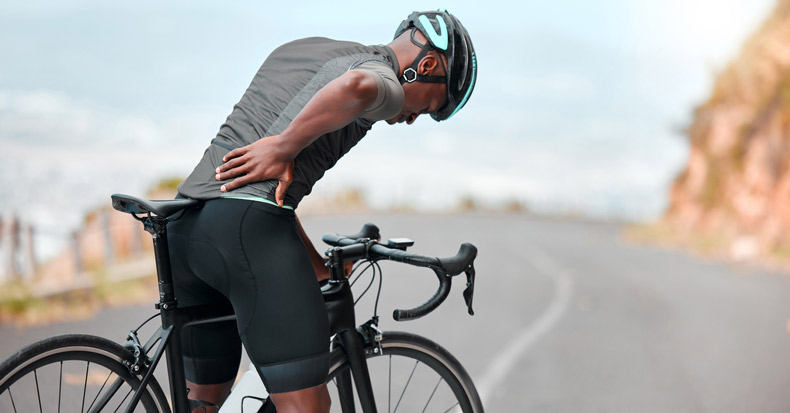Despite being considered a low-impact physical activity, many recreational and professional cyclists suffer from low back pain. Past studies have found the annual prevalence of low back pain among cyclists of all levels to be roughly 50%. The United Kingdom Health & Safety Executive report noted cycling-related low back pain accounts for roughly 233,000 missed days from work each month in the country—equivalent to about a million lost days of work for American workers! Why is low back pain so common for cyclists, and can anything be done to prevent it?
Current research suggests the culprit may be muscle fatigue. In an experiment that had cyclists pedal to exhaustion, researchers observed that as the hamstrings and calf muscles became progressively fatigued, the back increasingly bent forward in the lumbar (low back) region. Another study reported that holding the static bent-forward flexion position resulted in the low back extensor muscles becoming less effective at generating the forces needed to maintain spinal stability. These findings led to the conclusion that muscle fatigue leads to abnormal movement patterns, specifically excessive flexion that results in low back pain.
Because avoiding excessive muscle fatigue is key to reducing the risk for cycling-related back pain, experts offer the following tips to optimize riding:
- Saddle height: The knee should have a slight bend at the bottom of the stroke with the ball of the foot on the pedal and the hips should not move sideways during crank rotations.
- Saddle angle: This should be in a horizontal position parallel with the floor when viewed from the side or on a very slight downward tilt depending on comfort.
- Saddle type: Depending on comfort, a shorter front extension places less pressure in the perineal region for both genders.
- Forward/backward position of the saddle: With the pedals at 3:00 and 9:00 positions, a vertical line that passes just behind the kneecap on the outside of the forward knee should pass through the axle of the pedal.
- Handlebar position: With the elbow slightly bent, adjust the handlebars so that you don’t have to stretch to reach them or feel confined if they’re too close to your body. Adjust the height of the handlebars to minimize low back stress and strain, which is based primarily on comfort.
- From a technique standpoint, use a lower gear when traveling up inclines as struggling with a higher gear can load the muscles and joints with excessive forces.
Of course, if you make these adjustments and continue to experience low back pain, schedule an appointment with your doctor of chiropractic.



